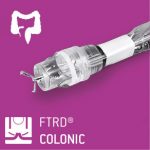A multicenter retrospective analysis of 50 patients undergoing EFTR for colonic lesions involving the appendiceal orifice showed an appendicitis rate of 14 % (7/50 patients). Four patients could be managed conservatively, in 3 cases surgical appendectomy was necessary.
S. Schmidbaur et al., University Clinic Ulm, Ulm, Germany, conducted a multicenter retrospective analysis of patients treated with endoscopic full-thickness resection with the FTRD System for colonic lesions involving the appendiceal orifice. The study aimed to evaluate the occurrence of appendicitis.
The FTRD System is suitable for resection in difficult anatomical locations with high risk of perforation, such as para-diverticular or para-appendicular lesions. In addition, the prompt closure provided by the FTRD device has been described as minimizing the risk of peritoneal irritation during resection by shortening the contact time between bowel lumen and peritoneal cavity. However, as EFTR near the appendiceal orifice is associated with a subtotal appendectomy, cases of acute appendicitis after resection have been described. The objective of this study was to further evaluate the risk associated with EFTR at this challenging location.
Overall, 50 patients with colonic lesions near the appendiceal orifice and without prior appendectomy could be included in the study. EFTR was technically successful in 48 of these patients (96 %). In the two remaining cases, the clip could not be deployed due to high angulation of the colonoscope; EMR could be successfully performed in these cases. Follow-up was terminated after a mean of 4 months after resection.
Seven patients (14 %) developed acute appendicitis during follow-up. Four appendicitis cases occurred during the first 10 days of post-interventional monitoring, the other three cases occurred after a latency period of < 1 month. In four patients, conservative management with intravenous hydration, antibiotics (3-5 days) and analgesics was sufficient. Three patients underwent surgical appendectomy. Three out of the four patients (75 %) with appendicitis during the first 10 days after the procedure were treated conservatively, and the other patient underwent surgery, whereas two out of the three patients (67 %) with later-onset appendicitis needed surgical therapy.
In one case of sessile serrated adenoma, post-interventional perforation of the cecum was observed and treated surgically. No other post-procedural complications (bleeding, severe pain, unexpected hospitalization) were reported.
The authors concluded that EFTR of lesions near or affecting the appendiceal orifice was associated with an acceptable complication rate. The risk of developing acute appendicitis was 14 %; however, 57 % of these cases could be treated conservatively owing to prompt detection. Further studies to determine risk factors for development of post-procedural appendicitis are mandatory.
Risk of appendicitis after endoscopic full-thickness resection of lesions involving the appendiceal orifice: a retrospective analysis
Schmidbaur S, Wannhoff A, Walter B, Meier B, Schäfer C, Meining A, Caca K
Endoscopy 2021; 53: 424–428. https://doi.org/10.1055/a-1227-4555
 |
 |


 Deutsch
Deutsch  Français
Français 